|
|

Books
We Like
Here are some books
that we have been reading lately. We usually feel lucky
if books on organization development and creativity contain
one useful idea. Most of these contain far more. Clicking
on the book cover will take you to AMAZON for more information.
Let us know what you have been reading!
|
| Featured
Book
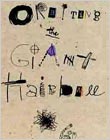  It's
ironic that books on creativity consistently lack
the very imagination that they purport to demonstrate.
I bought Orbiting the Giant Hairball: A corporate
fool's guide to surviving with grace at the
airport to read on the flight to a creativity conference
in Canada. I was so impressed that by the time I landed,
I decided to completely change my presentation. From
the title, to the format, to the artwork, to its inspirational
content, this book distinguishes itself from all the
rest. It's
ironic that books on creativity consistently lack
the very imagination that they purport to demonstrate.
I bought Orbiting the Giant Hairball: A corporate
fool's guide to surviving with grace at the
airport to read on the flight to a creativity conference
in Canada. I was so impressed that by the time I landed,
I decided to completely change my presentation. From
the title, to the format, to the artwork, to its inspirational
content, this book distinguishes itself from all the
rest.
Gordon McKenzie
worked at Hallmark Cards for thirty years ultimately
achieving the (self-created yet thoroughly respected)
position of "Creative Paradox." He uses
the metaphor of a "Giant Hairball" to represent
the tangle of impenetrable rules, procedures, policies,
and historic processes that organizations devise to
maintain their existence. Far from an idyllic celestial
body, however, the gravitation of this virtual "Death
Star" is capable of sucking the life forces of
creativity, imagination and vitality out of an organization.
The hairball constructs a vast wasteland of mediocrity
that constantly increases its own mass and powerful
attraction killing the lifeblood of existence - ideas.
Rather than
being tempted to escape to another planet, McKenzie
suggests that we learn to orbit the Hairball, stating
that in his thirty years at Hallmark, "there
was not a day when I was not subject to the inexorable
pull of Corporate Gravity tug, tug, tugging me toward
(and during one unhappy year, right into) the tangle
of the hairball where the ghosts of past successes
outvote original thinking." Using anecdotes,
strategies, and truly imaginative drawings, McKenzie
inspires us to find a place of balance that will enable
us to benefit from the resources of the organization
without becoming "entombed in the bureaucracy
of the institution." Hard to believe that this
started out as a sefl-published book. It will change
the way you think!
|
  Breakthrough
Teams for Breakneck Times: Unlocking the genius of
creative collaboration,
is an innovative handbook that compellingly presents
a fluid model of successful teamwork. Lisa Gundry
and Laurie LaMantia outline ten fundamental principles
of team collaboration brilliantly supplemented by
numerous tools, exercises, and case examples. This
well thought out framework yields a comprehensive
process that enables any team to take advantage of
its unique gifts and culture. The "Tools that
you can use" section in each chapter is more
than worth the price of admission. Highly recommended! Breakthrough
Teams for Breakneck Times: Unlocking the genius of
creative collaboration,
is an innovative handbook that compellingly presents
a fluid model of successful teamwork. Lisa Gundry
and Laurie LaMantia outline ten fundamental principles
of team collaboration brilliantly supplemented by
numerous tools, exercises, and case examples. This
well thought out framework yields a comprehensive
process that enables any team to take advantage of
its unique gifts and culture. The "Tools that
you can use" section in each chapter is more
than worth the price of admission. Highly recommended!
|
|
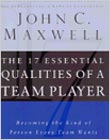  Ironically,
requiring seven more
principles, yet presented within considerably fewer
pages, John C. Maxwell's The 17 Essential
Qualities of a Team Player constructs
a simplistic model of teamwork that will likely be
only useful to the reader seeking the most basic information.
Taking a little more than a half hour to read and
an even a shorter time to digest, Maxwell's outline
of the most basic of team concepts is supplemented
by his characteristic extensive utilization of popular
quotes, bulleted lists, and very short case examples.
Extremely basic, yet useful for high school academic
or athletic contexts or as an introduction to basic
teamwork concepts to new board members of non-profit
organizations. Recommenced for basic training! Ironically,
requiring seven more
principles, yet presented within considerably fewer
pages, John C. Maxwell's The 17 Essential
Qualities of a Team Player constructs
a simplistic model of teamwork that will likely be
only useful to the reader seeking the most basic information.
Taking a little more than a half hour to read and
an even a shorter time to digest, Maxwell's outline
of the most basic of team concepts is supplemented
by his characteristic extensive utilization of popular
quotes, bulleted lists, and very short case examples.
Extremely basic, yet useful for high school academic
or athletic contexts or as an introduction to basic
teamwork concepts to new board members of non-profit
organizations. Recommenced for basic training!
|
|
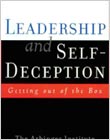  The
Arbinger Institute's Leadership and Self Deception:
Getting out of the box, convincingly illustrates
the process of self-deception that we engage in both
our professional and personal lives. Utilizing a modified
Socratic method within an engaging parable format,
the authors make a persuasive argument that we often
imprison ourselves by perceiving and treating others
as objects rather than human beings. Even though this
is often (self) justified as an attempt to "do
the right thing" or further the cause of productive
expediency, it frequently distorts reality. The
Arbinger Institute's Leadership and Self Deception:
Getting out of the box, convincingly illustrates
the process of self-deception that we engage in both
our professional and personal lives. Utilizing a modified
Socratic method within an engaging parable format,
the authors make a persuasive argument that we often
imprison ourselves by perceiving and treating others
as objects rather than human beings. Even though this
is often (self) justified as an attempt to "do
the right thing" or further the cause of productive
expediency, it frequently distorts reality.
The authors refer to this distortion
as an act of self-betrayal ultimately remanding us
to "solitary confinement" within a set of
constricted boundaries that limit our ability to lead,
be an effective team member, and/or successfully engage
in the creative process. Left uncorrected, the recursive
patterns that construct the "box" become
indelibly integrated into our personalities creating
more limitations for us and those whom we interact
with in our daily lives.
Although the principles outlined
in this book are somewhat similar to those Dan Goleman
put forth in Emotional Intelligence,
Leadership and Self Deception focuses more
specifically on the problems (and solutions) of leadership
and collaboration within an organizational context.
Peppered with spirited and thoughtful dialogue, this
181-page gem is illustrated with clever diagrams supplementing
its important message. Highly recommended!
|
|
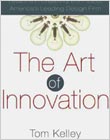  It
turns out that while creating the most cutting edge
product designs in the last 25 years, the folks at
IDEO managed to have a great time. In the book, The
Art of Innovation: Lessons in creativity from IDEO,
Tom Kelly, the company's general manager, illuminates
the pioneering design firm's distinctive creative
process while emphasizing the importance of maintaining
an open, collaborative, and (sometimes) wacky atmosphere
where great ideas are free to evolve. While this book
recounts many fascinating stories about designing
and redesigning familiar products - who would have
thought that a small hand demanded a fatter toothbrush
- it is succeeds most when outlining the human factors
that are key of to IDEO's success. It
turns out that while creating the most cutting edge
product designs in the last 25 years, the folks at
IDEO managed to have a great time. In the book, The
Art of Innovation: Lessons in creativity from IDEO,
Tom Kelly, the company's general manager, illuminates
the pioneering design firm's distinctive creative
process while emphasizing the importance of maintaining
an open, collaborative, and (sometimes) wacky atmosphere
where great ideas are free to evolve. While this book
recounts many fascinating stories about designing
and redesigning familiar products - who would have
thought that a small hand demanded a fatter toothbrush
- it is succeeds most when outlining the human factors
that are key of to IDEO's success.
On an engineering level this
best characterized by the concept of "observation
fueled insight" focusing on the importance of
actual human needs and interactions with a potential
new design. On a collaborative level, Kelly believes
that teamwork always beats the myth that creativity
flourishes within blissful solitude. On a purely practical
level, IDEO's seven secrets for better brainstorming
and the six ways to kill a brainstorm
are significant contributions to any process of creative
collaboration. All of this, Kelly points out, must
be supported with a framework of trust, risk taking,
and fun. Brilliant!
|
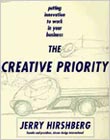  Jerry
Hirshberg, author of the Creative Priority,
did such a great job designing Nissan cars that they
featured him in their commercials. Founder of the
revolutionary Nissan Design International (NDI),
Hirshberg believes that diversity in the form of talent
and ideas is key to success in all creative endeavors.
This belief led him to originate the concepts of "creative
abrasion" and "divergent pairs," outlined
on another page in this website. Jerry
Hirshberg, author of the Creative Priority,
did such a great job designing Nissan cars that they
featured him in their commercials. Founder of the
revolutionary Nissan Design International (NDI),
Hirshberg believes that diversity in the form of talent
and ideas is key to success in all creative endeavors.
This belief led him to originate the concepts of "creative
abrasion" and "divergent pairs," outlined
on another page in this website.
Detailing the specific steps required to think
"outside the box," Hirshberg presents
ideas that are fresh, digestible, and practical
within the innovative thinking framework of NDI.
This framework is made up of eleven interlocking
strategies that became the group's "creative
priority." Similar to Tom Kelly (above), he
supplements great ideas this with fascinating anecdotes
and illustrations of NDI's innovative design illustrations.
By the way, this is the design group that put forth
the idea that modern car interiors should resemble
the comfort and accessibility of a "cocoon."
Inspiring
|
|
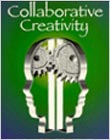  Demonstrating
a genuine reverence for the fragility and potential
of ideas, Jack Ricchiuto's Collaborative Creativity
is a "small" book with a lot of "big"
ideas. A highly respected project management, research,
design, and development consultant for many years,
he presents no less than 72 collaborative creativity
tools and observations in a little more than 100 pages. Demonstrating
a genuine reverence for the fragility and potential
of ideas, Jack Ricchiuto's Collaborative Creativity
is a "small" book with a lot of "big"
ideas. A highly respected project management, research,
design, and development consultant for many years,
he presents no less than 72 collaborative creativity
tools and observations in a little more than 100 pages.
Of particular usefulness are
his four innovation competencies that should be present
in relation to the creative process. Comparing these
competencies to the dynamic "riffs" of jazz
improvisers, he proposes that teams and individuals
collaboratively engaging in creative pursuits should
be ": 1) provocative, 2) open-minded, 3) practical,
and 4) inventive." This is one of the best books
that we have found integrating the critical ingredients
of creativity and collaboration. Big ideas in
a small book!
|
  Mihalyi
Csikszentmihaly's classic book, Flow
: The psychology of optimal experience, has been
very influential on our work and approach to creativity
and productivity. The author has studied human happiness
and its relationship to productivity for many years.
In one of his earliest popular books he presents his
research about the "altered state" of consciousness
that accompanies the creative act. Once you recognize
it, you can more easily access it. Check it out,
it will make a considerable difference in your personal
and professional life. A
classic! Mihalyi
Csikszentmihaly's classic book, Flow
: The psychology of optimal experience, has been
very influential on our work and approach to creativity
and productivity. The author has studied human happiness
and its relationship to productivity for many years.
In one of his earliest popular books he presents his
research about the "altered state" of consciousness
that accompanies the creative act. Once you recognize
it, you can more easily access it. Check it out,
it will make a considerable difference in your personal
and professional life. A
classic!
|
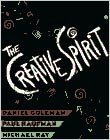  Paul
kaufman, Michael Ray, and Daniel Goleman's book The
Creative Spirit is a companion to the PBS series.
You wouldn't think that this type of book would have
that much to offer, but it does. It takes an insightful
look at the psychology of innovation and suggests helpful
exercises that can unlock creative potential. It is
an extremely readable and wonderful overview of the
subject. Dan Goleman, by the way, popularized the concept
of Emotional Intelligence and was chief editor
at Psychology Today and a frequent contributor
to the New York Times. Better
than T.V.! Paul
kaufman, Michael Ray, and Daniel Goleman's book The
Creative Spirit is a companion to the PBS series.
You wouldn't think that this type of book would have
that much to offer, but it does. It takes an insightful
look at the psychology of innovation and suggests helpful
exercises that can unlock creative potential. It is
an extremely readable and wonderful overview of the
subject. Dan Goleman, by the way, popularized the concept
of Emotional Intelligence and was chief editor
at Psychology Today and a frequent contributor
to the New York Times. Better
than T.V.!
|
|
| |
| |
|
|


